Sites from the Satsuma Rebellion:
The site of a fierce battle, close-quarter fighting at Tabaruzaka is
excavated. A priceless discovery from the opening of the modern
period is made.
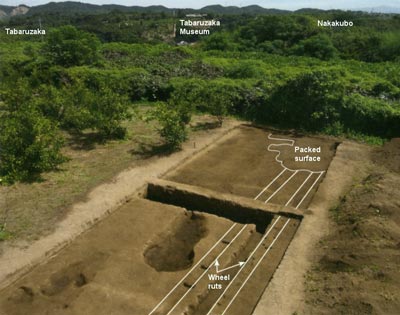 The view facing Tabaruzaka and Nakakubo from the Futamata Uryūda Government Army Battery Site A panorama of the investigated area is in the foreground. Ruts from cannon wheels point toward the Satsuma army’s battery, slightly south of Tabaruzaka. Adapted from Hakkutsu
sareta Nihon rettō 2012
[Excavations in the Japanese Archipelago, 2012] (Bunkachō
[Agency for Cultural Affairs], ed., Asahi Shimbun Publications,
2012).
|
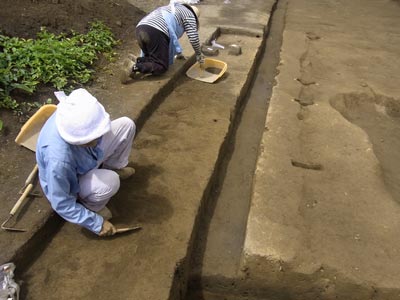 Cannon wheel ruts in situ The distance between the two parallel-running ruts is 75-80 cm, matching the track width of the mountain gun known as shikin sanpō. This was a muzzle-loading artillery piece, and just ahead of the ruts a hard, packed surface (the work area) was detected. |
 Map of the battle near Tabaruzaka Orange lines show the government army’s positions, while those of the Satsuma army are in blue. The arrow shows the direction of cannon alignment. Adapted from Hakkutsu
sareta Nihon rettō 2012
[Excavations in the Japanese Archipelago, 2012] (Bunkachō
[Agency for Cultural Affairs], ed., Asahi Shimbun Publications,
2012), originally from Meiji
10 nen Seinan Sen’eki: Tabaru, Kichiji, Ueki sensekizu
[The Satsuma Rebellion of Meiji 10: Map of the Tabaru, Kichiji, and
Ueki Battlegrounds] (Kumamoto Prefecture Board of Education et al.,
1920).
|
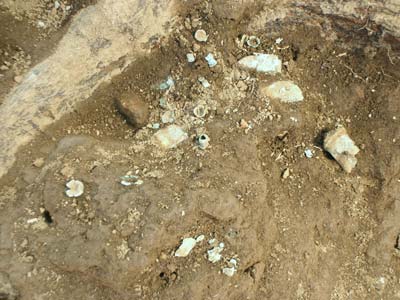  Yamagashira Site, Satsuma army battle position remains (left, finds of detonators in situ) Foxholes of the Satsuma army battle position remains were small in scale compared with the traces of government army trenches, being about 3 m in length by 1.6 m wide, full if occupied by two or three men. But 680 detonators and 150 cartridges were recovered, the number of rounds fired being greater than for the government army. This was a vital battle position, guarding the right flank of the Satsuma army’s base at the Ogisako Kakinoki fort. |
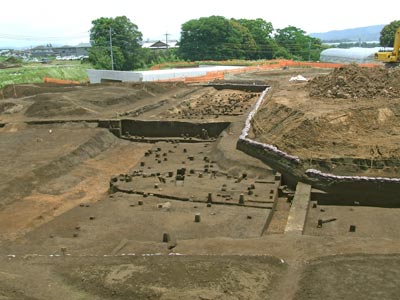 Yamagashira Site, panorama of the southern half of the government army trench (from the north) The remains of the trench, which utilized a sunken field, were in an L-shape 115 m in length, 8 m wide, and 0.8 m deep, on a grand scale differing from hurriedly dug, ordinary trenches. From the state of preservation of fragile artifacts such as shell cases, and from the deposited strata, it is thought to have been partially filled in shortly after the fighting ended. The Satsuma army battle positions were located at the stand of trees to the left at the top of the image. | |
Sites from the Satsuma Rebellion (Futamata Uryūda Government Army Battery Site, Yamagashira Site), Gyokutō Town and Kumamoto City, Kumamoto Prefecture
Japan’s last civil war
The Satsuma Rebellion was the last civil war in Japan, occurring in the tenth year of the Meiji era (1877), when the Satsuma rebel forces centering on Saigō Takamori of Kagoshima collided with the regular army of the new Meiji government not long after it had formed. As the Satsuma army went northward across Kyushu, in order to advance toward Tokyo by land, the government army journeyed south to block them.
Battlefields spread over a wide area in Kumamoto, Ōita, Miyazaki, and Kagoshima prefectures, with fighting spanning a seven-month period from February to September.
In March the two armies clashed at Tabaruzaka, on the main road leading to Kumamoto castle and the only one allowing cannon to pass, and where moreover the topography was easily defended and difficult to attack. For the Satsuma Rebellion as a whole there were about 14,000 lives lost in battle for the two armies, with several times that number of wounded, and civilians in the vicinities of the battle sites were also inflicted with great sacrifices and burdens.
Futamata Uryūda Government Army Battery Site
This site is atop a terrace 98 m in elevation, and about 900 m southwest from Tabaruzaka. It is the remains of a field artillery battery built by the government army in order to bombard the Satsuma force in the fighting at Tabaruzaka, which unfolded from the 3rd to the 20th of March. Copper friction tubes, for firing cannon, and rifle bullets were found here. Wheel ruts were also discovered, thought to be those of the main artillery piece in use at the time, a mountain gun called shikin sanpō.
As in the words of a folk song, “It rains and it rains, the men and horses get soaked,” it is related that many days during the fighting were rainy. These are rare features, the traces of warfare etched deep into a ground surface turned into mud by the rain.
There are sites related to the Satsuma Rebellion throughout Kyushu, and along with the remains of trenches and defensive positions, stories and legends also survive.
Yamagashira Site
This site sits atop a tableland roughly 95 m in elevation, approximately 4.7 km southeast from Tabaruzaka. There are remains of the government army’s trenches and the Satsuma force’s battle positions, and as the result of excavation, many artifacts pointing to combat were found, such as rifle bullets and shell cases. The two armies confronted each other across narrow valley at a point-blank distance of about 50 to 100 m, close enough for voices to be heard and faces distinguished. This is the first site in the nation at which the condition of the two armies, inferred to have exchanged fire directly, was confirmed through the features and accompanying artifacts ascertained by excavation.
Technology of modern warfare, also confirmed from features
At this site of a great and fierce battle of the Satsuma Rebellion, straddling Gyokutō Town and Uekimachi, Kumamoto City, the remains of artillery batteries and close fighting have been ascertained. The time was the transition between the age of samurai and the modern period. This site may be called a precious example of the traces of this process coming to light. (Futamata Uryūda: Miyamoto Chieko; Yamagashira: Nakahara Mikihiko)
principal artifacts, Futamata Uryūda Government Army Battery Site, Yamagashira Site
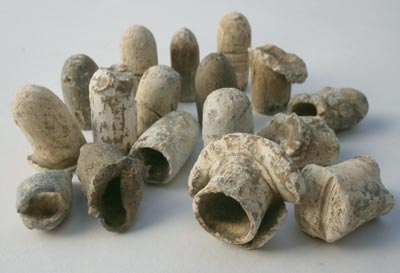 Rifle bullets fired by the Satsuma army (Yamagashira Site) Date: 1877. (For a single item) Length: 2.8 cm; diameter: 1.5 cm; weight: 35 gm. A variety of bullet types were recovered from the government army battle positions. These were fired by Lee-Enfield, Snider-Enfield, Wesley-Richards and other makes of rifle, so it appears that the Satsuma army was using various types. Rifle bullets were mostly machine-made, but there are also hand-made items fashioned with pincer-shaped molds, matching stories of munitions being procured locally. The bullets are made of lead and are soft, and as some items were greatly deformed from impact, it is inferred that defensive positions were made not just with sandbags but also materials such as grave stones. |
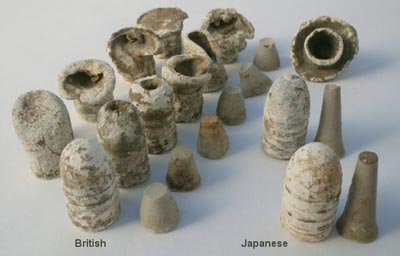 Rifle bullets fired by the government army (Yamagashira Site) Year 10 of the Meiji era (1877). (For a single item) Length: 2.5 cm; diameter: 1.4 cm; weight: 30 gm. Bullets fired by the government army were from Snider-Enfield rifles only, matching the condition of the shell cases recovered from the trench remains. The bullets had 4 Tamisier ball grooves which served to stabilize the trajectory, and while the range was reduced the accuracy was held to be good. Rifles, with spiral grooves in the barrel, had become the main type for small arms; bullets fired from them revolved in flight and have traces left by the grooves (rifling). From the shape of the hollow depression in the base it is thought that there were two types, of British and Japanese make. Adapted from Hakkutsu
sareta Nihon rettō 2012
[Excavations in the Japanese Archipelago, 2012] (Bunkachō
[Agency for Cultural Affairs], ed., Asahi Shimbun Publications,
2012).
|
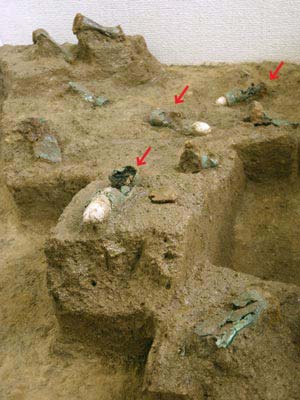 Close-up of unused Snider-Enfield bullets, cartridges in situ Year 10 of the Meiji era (1877). (Unused bullet) Length: 6.2 cm; diameter: 1.5 cm; weight: 38 gm. (Cartridge shell) Length: 5.1 cm; diameter: 1.5 cm; weight: 8 gm. These were recovered from the government army trench. Black gunpowder (arrows) still remains in the unused bullets, and the reaction of the saltpeter in the powder with moisture from the soil has eroded the shell cases. The cylindrical cases are made by rolling sheets of brass, and the case bottoms are of two types, iron and brass. This difference indicates older and newer manufacture, with the Mark I brass items already outdated at this time, and it is thought they were discarded because they were poorly suited to the main type of rifle in use. |
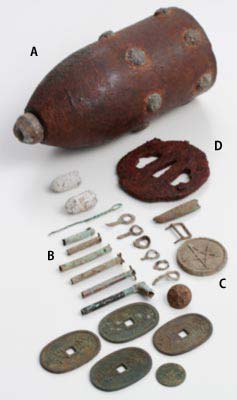 Government
army artifacts (Futamata Uryūda Government Army Battery Site)
Government
army artifacts (Futamata Uryūda Government Army Battery Site)
Year 10 of the Meiji era (1877). (A) Artillery shell for a shikin mountain gun (collected at Harakura in Gyokutō Town) Length: 18 cm; diameter: 8.5 cm; weight: 4 kg. This is the cannon used at Tabaruzaka. This gun could be dismantled for transport, and had a range of approximately 3 km, although for accurate firing the range was about 1 km. Designed to explode on impact, when it hit the shell would be ripped open by the gunpowder, damaging defensive positions and buildings. (B) Friction tubes Length: 4.5 cm; diameter: 0.5 cm; weight: 3.2 gm. This item was inserted through the vent (fuse hole) at the rear of the cannon into the charge (powder), and when the friction bar was pulled out vigorously by its looped end, the resulting friction lit the charge. These are thought to have been expendable items used and discarded in the manner of matches. (C) Badge for a cap Diameter: 4.1 cm; height: 0.5 cm; weight: 20.4 gm. This is a cap badge on which a pentagram is fashioned. The back side has two holes, so that it could be sewn onto a hat. (D) Sword guard of the Battōtai (recovered from the Yokohirayama battle site) Length: 8.0 cm; diameter: shortest diameter 7.4 cm; thickness: 0.6 cm. This is an iron sword guard recovered from the Yokohirayama battle site, a place of fierce fighting near the Futamata Uryūda Government Army Battery Site. Yokohirayama is where the Battōtai, a special combat force drawn from the military police, attacked in a raid and repelled the Satsuma army. While it is not clear to which side this item belonged, it may be called an artifact symbolizing the end of the era of the sword. |
